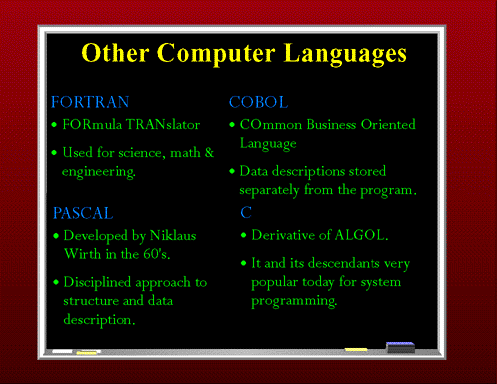BASIC & Other Languages |

|
BASIC was not the only game in town. By this time, a number of other specialized and general-purpose languages had been developed. A surprising number of today's popular languages have actually been around since the 1950s. FORTRAN, developed by a team of IBM programmers, was one of the first high- level languages--languages in which the programmer does not have to deal with the machine code of 0s and 1s. It was designed to express scientific and mathematical formulas. For a high-level language, it was not very easy to program in. Luckily, better languages came along.
In 1958, a group of computer scientists met in Zurich and from this meeting came ALGOL--ALGOrithmic Language. ALGOL was intended to be a universal, machine-independent language, but they were not successful as they did not have the same close association with IBM as did FORTRAN. A derivative of ALGOL-- ALGOL-60--came to be known as C, which is the standard choice for programming requiring detailed control of hardware. After that came COBOL--COmmon Business Oriented Language. COBOL was developed in 1960 by a joint committee. It was designed to produce applications for the business world and had the novice approach of separating the data descriptions from the actual program. This enabled the data descriptions to be referred to by many different programs.
In the late 1960s, a Swiss computer scientist, Niklaus Wirth, would release the first of many languages. His first language, called Pascal, forced programmers to program in a structured, logical fashion and pay close attention to the different types of data in use. He later followed up on Pascal with Modula-II and III, which were very similar to Pascal in structure and syntax.
Computers: From the Past to the Present
Other Languages:
Last modified July 30, 2006
©1994-2006 by Michelle A. Hoyle